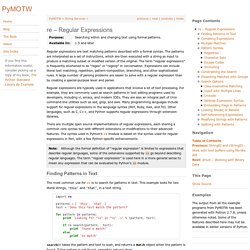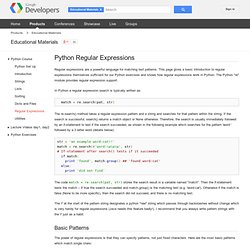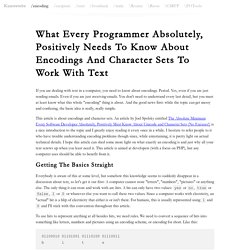

Debuggex: Online visual regex tester. JavaScript, Python, and PCRE. Writing programs using ordinary language. In a pair of recent papers, researchers at MIT’s Computer Science and Artificial Intelligence Laboratory have demonstrated that, for a few specific tasks, it’s possible to write computer programs using ordinary language rather than special-purpose programming languages.

The work may be of some help to programmers, and it could let nonprogrammers manipulate common types of files — like word-processing documents and spreadsheets — in ways that previously required familiarity with programming languages. But the researchers’ methods could also prove applicable to other programming tasks, expanding the range of contexts in which programmers can specify functions using ordinary language. “I don’t think that we will be able to do this for everything in programming, but there are areas where there are a lot of examples of how humans have done translation,” says Regina Barzilay, an associate professor of computer science and electrical engineering and a co-author on both papers. Opening gambit. Rubular: a Ruby regular expression editor and tester. RegExr. Re – Regular Expressions. Regular expressions are text matching patterns described with a formal syntax.

The patterns are interpreted as a set of instructions, which are then executed with a string as input to produce a matching subset or modified version of the original. The term “regular expressions” is frequently shortened to as “regex” or “regexp” in conversation. Expressions can include literal text matching, repetition, pattern-composition, branching, and other sophisticated rules. A large number of parsing problems are easier to solve with a regular expression than by creating a special-purpose lexer and parser.
Regular expressions are typically used in applications that involve a lot of text processing. There are multiple open source implementations of regular expressions, each sharing a common core syntax but with different extensions or modifications to their advanced features. Note. Python Regex Tool. Python Regular Expressions - Educational Materials. Regular expressions are a powerful language for matching text patterns.

This page gives a basic introduction to regular expressions themselves sufficient for our Python exercises and shows how regular expressions work in Python. The Python "re" module provides regular expression support. In Python a regular expression search is typically written as: match = re.search(pat, str) The re.search() method takes a regular expression pattern and a string and searches for that pattern within the string. Str = 'an example word:cat!!
' The code match = re.search(pat, str) stores the search result in a variable named "match". The 'r' at the start of the pattern string designates a python "raw" string which passes through backslashes without change which is very handy for regular expressions (Java needs this feature badly!).
Basic Patterns The power of regular expressions is that they can specify patterns, not just fixed characters. A, X, 9, < -- ordinary characters just match themselves exactly. Findall. Regular Expressions (RegEx) - Quick Reference. What every programmer absolutely, positively needs to know about encodings and character sets to work with text — kunststube.net. If you are dealing with text in a computer, you need to know about encodings.

Period. Yes, even if you are just sending emails. Even if you are just receiving emails. You don't need to understand every last detail, but you must at least know what this whole "encoding" thing is about. And the good news first: while the topic can get messy and confusing, the basic idea is really, really simple. This article is about encodings and character sets.
Getting the basics straight Everybody is aware of this at some level, but somehow this knowledge seems to suddenly disappear in a discussion about text, so let's get it out first: A computer cannot store "letters", "numbers", "pictures" or anything else. To use bits to represent anything at all besides bits, we need rules. 01100010 01101001 01110100 01110011 b i t s In this encoding, 01100010 stands for the letter "b", 01101001 for the letter "i", 01110100 stands for "t" and 01110011 for "s". The above encoding scheme happens to be ASCII. Code page. Regex Crossword.